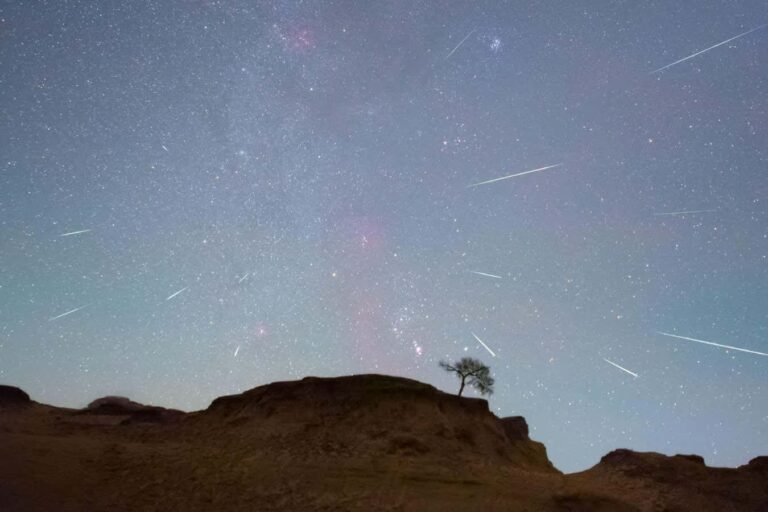Orionid meteor shower seen over Daqing, Heilongjiang Province, China on October 22, 2020
Sipa US / Alamy
The Orionid meteor shower began on October 2nd this year and ends on November 7th, but its peak should be on the night of October 21st, with the brightest meteors visible in the early morning hours. This is one of the most reliably active annual meteor showers and should be visible all over the world. As long as you can see Orion, also known as the Hunter, there’s a good chance you’ll be in for a great show. During this period, the moon is only partially illuminated, so you should see about 20 meteors per hour in clear skies.
What is a meteor shower?
A meteor is a flash of light that occurs when debris enters the atmosphere and rapidly heats up, emitting an intensely bright light. Usually they occur randomly, but when Earth passes through a cloud of comet debris, more meteors can be seen over a period of days or weeks, depending on the size of the cloud.
Why are they called the Orionid meteor shower?
The Orionid meteor shower is named for the fact that it appears to come from the constellation Orion, but these distant stars have nothing to do with the production of the meteors themselves. This flash is actually a fragment of Halley’s Comet, which visits Earth’s vicinity approximately once every 75 years and was last observed in 1986. The comet itself is a rare event, and the Earth rocks a field of its debris every year.
How can I observe the Orionid meteor shower?
To some extent it will depend on the weather. Assuming the skies are clear, look for a location with minimal light pollution and avoid using flashlights or cell phone light to help your eyes adjust to the darkness. The highest incidence of meteors is from after midnight to before dawn.
The Orionid meteor should be visible throughout the night sky, but because of the angle at which the Earth passes through the comet’s tail, it appears to radiate out from the constellation Orion. Each meteor lasts only a few seconds and flies across the sky. Not to be confused with satellites. Satellites move smoothly across the sky for much longer periods of time.
How can I find Orion?
Orion is one of the easiest constellations to find because it is made up of many bright stars and aligns with the Earth’s equator. Therefore, for at least part of the year, it can be seen from almost anywhere in the world. In the Northern Hemisphere, Orion can be seen from September, but it is best seen from January to March.
Orion’s most obvious feature is the line of three bright stars that form the Hunter’s Belt. These stars, called Alnitak, Alnilam, and Mintaka, are fairly evenly spaced and have similar brightness. Just when he thinks he’s found the belt, he starts looking in the sky for other bright stars that make up the constellation Orion, such as Rigel, the sixth brightest star (in the northern hemisphere it should be in the lower right), and the faint star Betelgeuse. I can. A red star in the upper left shoulder of the constellation Orion in the northern hemisphere. In the southern hemisphere, the positions are reversed, with Rigel at the top left and Betelgeuse at the bottom right.

Halley’s Comet was last observed in 1986.
NASA JPL/California Institute of Technology
What is Halley’s Comet?
Halley’s Comet is a 15-kilometer-wide ball of dust and ice that passes close to Earth approximately every 75 years. It is a short-period comet, defined as having an orbit around the Earth that lasts less than 200 years. The comet was last seen in February 1986 and is scheduled to return in July 2061.
Scientists believe that comets like Halley’s comet originated in the far reaches of our solar system, such as in the icy Oort cloud. Over time, the gravity of the sun and planets has drawn comets like Halley’s comet toward the center of the solar system in their orbits.
topic:



